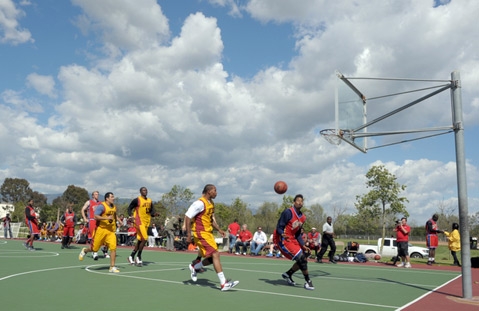Girsh Park’s Creative Map to Success
How a Unique Private-Public Partnership Powers Goleta’s Recreational Hub

Even in the midday heat, Girsh Park is humming with activity: there’s a lively pick-up basketball game in progress, a group of kids practicing soccer, a mother reading to two little boys in the welcoming shade of a tree. The 25-acre park is a landscape people engage with, a setting that draws folks of all ages and income levels, and executive director Ryan Harrington is understandably proud. “This is one location that brings everyone together,” he said. “Kids and adults with different norms, values, socioeconomic levels, all gathering for games, picnics, birthdays…even quinceañeras and weddings.“
The park was originally envisioned in 1998 as a buffer of open space on land owned by Dr. Lester Girsh between the Camino Real Marketplace and the neighborhood around it. Girsh entrusted the project to developer Mark Linehan, who saw the need for an active community park in Goleta and went beyond mere buffer, creating a 12-acre park that included a soccer field, softball field, basketball courts, picnic area, playground, and community room. When the County of Santa Barbara declined to take over the park, Linehan organized it as a nonprofit entity with a board of community-minded citizens, and The Foundation for Girsh Park was born.
A creative business model evolved. “The foundation relies on user fees from entities such as Dos Pueblos Little League and AYSO, an endowment, fundraising campaigns, corporate sponsors such as Marborg Industries, and funding from the City of Goleta,” Harrington explained. “It’s an unusual partnership of private and public entities.”
An additional 12 acres for little league baseball, now called Elings Fields, was acquired in 2003, a subsequent capital campaign helped finance the building of a state-of-the-art soccer field, and a current campaign will fund a fieldhouse, a concession stand with a commercial kitchen, and other improvements. “At this point we are basically the parks and rec department for the City of Goleta,” said Harrington. “We don’t facilitate our own programs, but we maintain and oversee the facility. We focus on what we’re good at. We’re a recreation enterprise.“
And Girsh Park does seem like an enterprise: innovative, inventive, and responsive to community needs. As we walk around outdoors, Harrington shows me where the Goleta Chamber of Commerce hosts its annual Lemon Festival, where the Rotary Club offers fireworks on Fourth of July, and the meadow where the Easter egg hunt happens. He mentions the use of reclaimed water and explains the advantages of synthetic turf on Goleta’s clay soil as a superior playing surface and water-saving measure. He points out a fountain with a fitting that facilitates refilling of water bottles, observes places where good shade trees will thrive, espouses his thoughts on playground equipment. He contemplates how welcome food and refreshments will be at baseball games, as well as the potential revenue of leasing the kitchen space to a provider.
“In general, parks don’t make money,” Harrington said. “It’s really difficult to make them self-sustaining.” But by combining fee-for-service income, private donations, endowment interest, and city contributions, Girsh Park succeeds, and the collective good it yields cannot be measured. “I think it’s fair to say we’re mitigating problems of obesity, drug use, even depression …” mused Harrington.
The park generates upwards of 350,000 visits per year, and in Harrington’s view, may well be the true heart of Goleta. “It’s one place to go for most of your recreational needs,” he said. “We’re a multi-generational facility with people from all different backgrounds. When they get here and use the park, they’re all on the same level. They’re all playing by the same rules. It’s kind of a beautiful thing.”
See girshpark.org.



